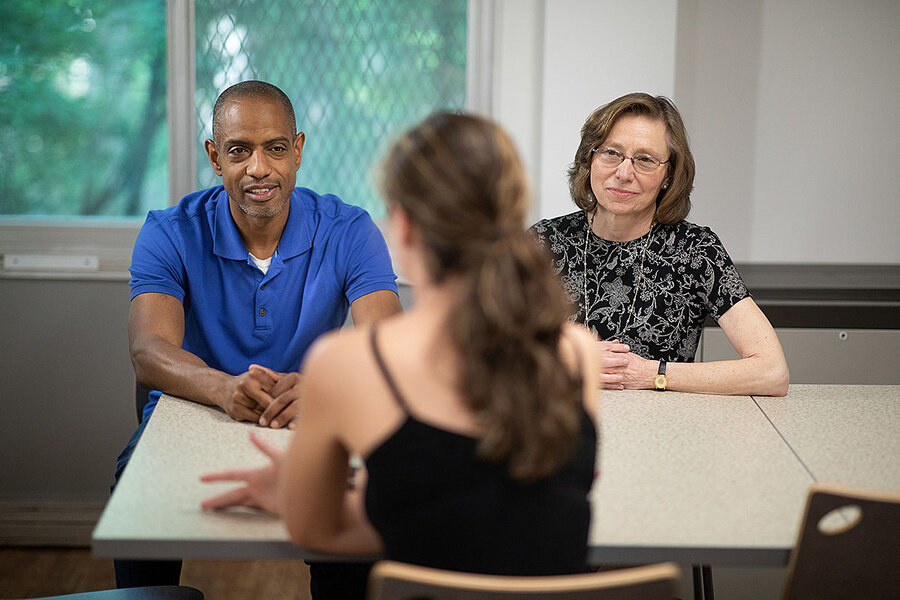Colleges respond to opioid crisis with resources, 'recovery houses'
Loading...
| NEW BRUNSWICK, N.J.
The first time Cherise tried college, she lasted only a couple of months.
Lonely and miserable, the Rutgers University freshman turned to heroin, and quickly became addicted. She dropped out of school and after what she describes as an “intentional overdose” in 2014, wound up in a rehab facility near the campus in New Brunswick, N.J., just down the street from fraternity row.
It was there that she heard about Rutgers Recovery House, a year-round dorm where students recovering from drug and alcohol addictions can find friendship and sanctuary from the temptations of college life.
Believing it was “meant to be,” she re-enrolled at Rutgers, and moved into the Recovery House.
“I was home,” says Cherise, who, like all the students in the house, asked that her last name not be used. Now 28, she graduated in the spring.
Almost unheard of five years ago, collegiate recovery programs are multiplying amid an opioid epidemic that claimed the lives of 4,110 Americans under 25 in 2016, the last year for which the figure is available. That’s almost double the number of young people who died of opioid overdoses in 2006.
Those statistics, and a flurry of seed funds from state governments and nonprofit organizations, are compelling colleges to take the often joked-about issue of campus drug use much more seriously, acknowledging a problem that still makes many campus leaders — especially in recruitment, development, and alumni offices — uncomfortable.
Before opioids, colleges “were able to sweep it under the carpet better,” says Christopher Freeman, community recovery supervisor at The College of New Jersey in Ewing. Students were abusing drugs and alcohol — they just weren’t as likely to die.
In 2013, there were a couple dozen collegiate recovery programs; today, there are around 200, according to advocates.
Changing attitudes toward addiction
The epidemic has also accelerated a shift in attitudes toward addiction, these advocates say. Long condemned as a moral failing, addiction is increasingly seen as a public health issue, worthy of public dollars. New Jersey, West Virginia, and North Carolina all provide grants to colleges toward the cost of running recovery programs. New Jersey’s legislature passed a law in 2015 requiring most public colleges to have recovery housing.
Research suggests that recovery programs benefit both students and colleges. One national survey found that students who participate in such programs have higher grade point averages than their peers and are more likely to graduate. Just 8 percent relapse, on average.
Still, collegiate recovery programs remain relatively rare — fewer than 5 percent of campuses have them — and many college leaders remain skeptical they’re even needed. There’s not a lot of data on addiction among college students, and what little there is suggests that, contrary to depictions in popular culture, they abuse drugs at lower rates than their peers who aren’t enrolled.
One in 5 full-time college students reported using an illicit drug other than — and usually in addition to — marijuana at least once in the previous 12 months, a national survey by the University of Michigan for the National Institutes of Health found. That’s slightly lower than the 24 percent of recent high school graduates who aren’t in college who said they’d used them. Another survey, by the federal Substance Abuse and Mental Health Services Administration found rates of illicit drug use among all 18-to-25-year olds to be as high as 38 percent.
But advocates for the recovery programs say many college leaders are in a state of willful denial, reluctant to admit a problem that might harm their institutions’ reputations or dampen recruitment.
“They don’t want parents walking around campus seeing posters that imply there is any kind of a substance abuse problem on campus,” says James Winnefeld, a retired U.S. Navy admiral and former vice chairman of the Joint Chiefs of Staff who started an organization to tackle the opioid epidemic after his son overdosed in his dorm room last year, just four days after enrolling as a freshman at the University of Denver.
This semester, DU opened a community center for students who are in recovery. While the center does not offer housing, a spokeswoman says the college plans to set aside a floor of an existing apartment complex for recovery housing next year.
Other collegiate recovery programs are long established. The first was created at Brown University in 1977, by a classics professor who was himself recovering from an alcohol addiction. Rutgers followed suit in 1983, after a student who had been drinking fell from some bleachers and became paralyzed. But the real growth has come since 2013, when a nonprofit organization called Transforming Youth Recovery began offering grants to colleges to start programs. Over the past five years, the nonprofit, which was started by a woman who lost her son to an opioid overdose, has given out $1.3 million in grants to 161 colleges.
Recovery programs vary in size and scope, but most offer 12-step or other support groups, “sober social” events, and awareness-raising activities, according to a survey by Transforming Youth Recovery. Just under half provide professional counseling, and roughly 10 percent include housing. A few have started offering medication-assisted treatment, weaning students off of opioids with the help of drugs that lessen their cravings for them.
The Rutgers approach
At Rutgers, the Recovery House is much more than a chem-free dorm. For Cherise and the 24 other students who live there, it’s an antidote to the loneliness that many people recovering from an addiction feel among peers who don’t understand why they can’t have “just one drink.”
“I don’t want to have a glass of wine, I want the whole bottle. It’s so hard to tell another person what that’s like,” says Andrea, a graduate student. “Here, I don’t feel alone.”
The dorm is also a refuge from the broader campus, where a culture of casual drug use and binge-drinking can jeopardize recovery. Advocates refer to colleges as “recovery-hostile” environments.
“There are triggers anywhere you go — there’s just more on a college campus,” says Devon, who is a rising sophomore. “You go outside and you smell weed. It’s easier to get drugs here than anywhere else.”
There are two things that keep her from succumbing to these temptations, Devon says as she sits with a group of other women in the Rutgers Recovery House’s lounge. One is that “this place is always open,” even during breaks. The other: Students who relapse are required to move out.
Students here say they hold each other accountable and are quick to notice when a dormmate is struggling. When Devon was tempted to relapse recently, she went to her friends and told them, “Don’t let me.” And when Cherise had anxiety attacks during finals week, she says, a fellow recovering student, Jen, sat with her and helped her breathe.
Most students aren’t so fortunate. On a vast majority of campuses, those in recovery still face an impossible choice: “Return to the same environment that fed my problem, or prioritize my health and forgo my education,” says Amy Boyd Austin, president of the Association of Recovery in Higher Education.
Barriers to more programs
Advocates say there are two reasons there aren’t more programs: money and stigma.
When money is tight, many colleges prioritize prevention and response, investing their limited dollars in efforts to stop substance abuse and treat it when it occurs. Many remain focused on the much more pervasive problem of marijuana and alcohol abuse. In the University of Michigan survey, nearly two-thirds of students said they had been drunk at least once in the previous 12 months, and almost 40 percent said they had used marijuana — the highest rate since 1987.
The stigma surrounding drug and alcohol addiction is subsiding as students become more open about their struggles, advocates say. But it’s far from gone. Many college leaders continue to say they don’t have recovering addicts on their campuses, a claim made easier by the lack of reliable data on addiction rates among college students.
“Most schools are still in denial,” says Kristen Harper, a consultant with Transforming Youth Recovery.
Often it takes a tragedy to spur a college into action. But Mr. Freeman, of The College of New Jersey, says that even if the numbers of students who would benefit from recovery programs is small, it’s an investment worth making.
“For the students who are involved with them, they’re absolutely life-changing,” he says. “If we don’t pay now to help people recover and lead productive lives, we will pay later.”
Cherise, who started down the path to addiction when she was just 11, says she probably wouldn’t have made it through college without the recovery house. She says she “learned how to be part of a family” in the dorm.
“This is a priceless place,” she says. “There’s unconditional love.”
This story about drug treatment and recovery for college students was produced by The Hechinger Report, a nonprofit, independent news organization focused on inequality and innovation in education.







